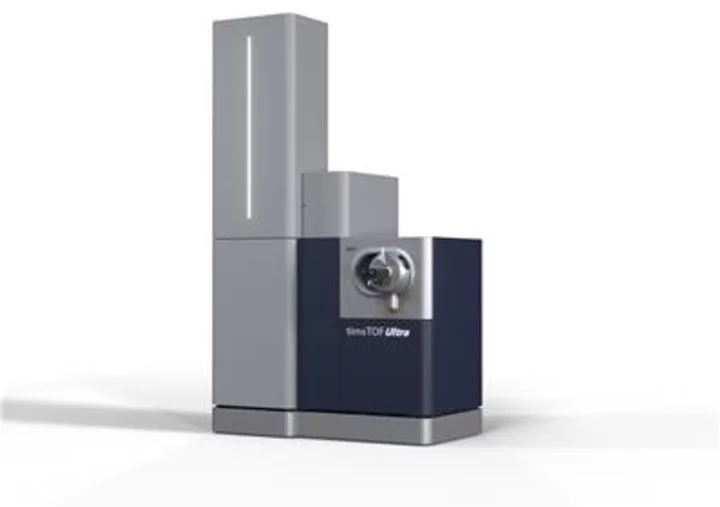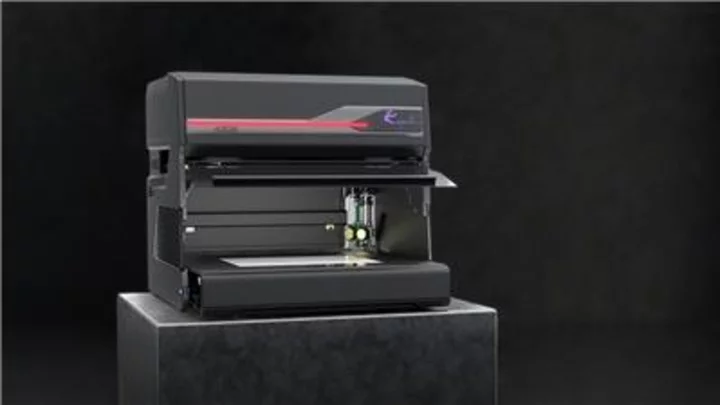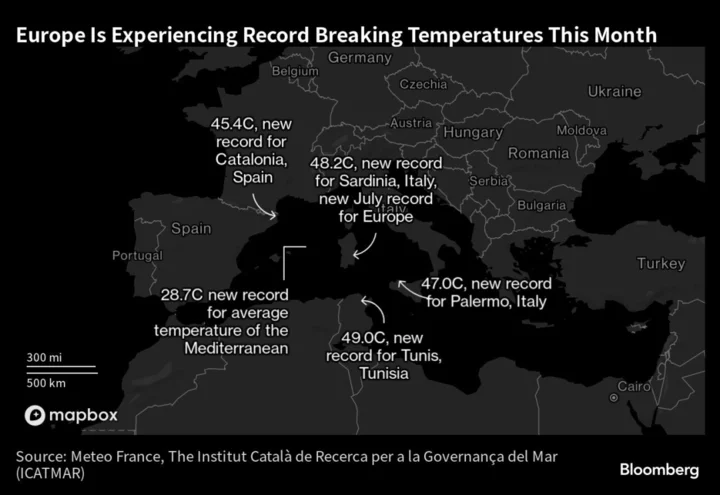HOUSTON--(BUSINESS WIRE)--Jun 5, 2023--
At the 71 st ASMS meeting, Bruker Corporation (Nasdaq: BRKR) announced transformative sensitivity on the 4D-Proteomics timsTOF platform with the launch of the new timsTOF Ultra mass spectrometer. It incorporates a new Captive Spray Ionization (CSI) Ultra ion source with larger capillary and optimized vortex gas flow, a novel 4 th -generation TIMS (trapped ion mobility separation) XR cell and 14bit digitizer. The timsTOF Ultra can identify over 55K peptides that map into 5000 protein groups at the single-cell level of 0.125 ng protein loading, at 1% FDR, and over 4800 protein groups quantified at CVs of <20%. This breakthrough sensitivity and quantitation performance below the 1 ng protein load level sets a new benchmark. Unparalleled sensitivity, with the proven robustness of the timsTOF platform, and with PASEF duty cycle now up to 300 Hz for MS/MS, offers significant further performance improvements for ultra-low sample amounts, including unbiased single-cell proteomics and single-cell lipidomics, unbiased spatial proteomics, immunopeptidomics, phosphoproteomics, PTM analysis, and protein-protein interaction (PPI) studies.
This press release features multimedia. View the full release here: https://www.businesswire.com/news/home/20230605005326/en/
timsTOF Ultra mass spectrometer (Photo: Business Wire)
Dr. Fabian Coscia, Group Leader for Spatial Proteomics at the Max Delbruck Center, Berlin, Germany, said: “The single-cell sensitivity dia-PASEF workflow on the timsTOF Ultra has brought our low-input tissue proteomics research to a new level. Using a 20-min nanoflow LC gradient combined with Bruker’s optimized dia-PASEF (3x8 window) method, we can now reproducibly quantify 1,500 – 2,000 proteins from laser micro-dissected mouse liver FFPE tissue of only 1,500 µm 2, regions corresponding to approximately 1-2 hepatocytes.”
These timsTOF Ultra advances have been achieved without compromising the excellent robustness for high-throughput proteomics, e.g., at 50 samples per day (SPD), or even up to 398 SPD, nor the highest identification confidence of <1% peptide and <1% protein FDRs (false discovery rates), avoiding the cross-reactivity seen with targeted immune-recognition methods.
Professor Dr. Karl Mechtler, Proteomics Head at the Innovation Hub of the Research Institute for Molecular Pathology (IMP), Gregor Mendel Institute (GMI), and the Institute of Molecular Biotechnology of the Austrian Academy of Sciences (IMBA), added: “To truly understand cellular mechanisms and diseases, it's crucial to differentiate between the various cell types. While single-cell analysis has been game-changing, we face obstacles in maximizing its potential for throughput and proteins groups that can be analyzed. It would make biological sense to detect 6000 or more proteins in a single-cell experiment. The timsTOF Ultra has overcome these barriers, allowing us to explore the proteome of individual cells at speed and unparalleled sensitivity. Thanks to the timsTOF Ultra, single-cell analysis has reached new heights, and I'm excited to see where this breakthrough will lead us next.”
Bruker also introduces VistaScan software for synchronizing TIMS ramp with the quadrupole scan to further benefit from ion mobility information at scale. This sophisticated dynamic linked-ramp supports the novel midia-PASEF mode, introduced by Stefan Tenzer ( doi.org/10.1101/2023.01.30.526204 ).
Dr. Stefan Tenzer, Professor for Quantitative Proteomics and Head of MS Core Facility, Johannes Gutenberg University Mainz, commented: “Our laboratory focuses on methods for quantitative proteomics that require highest sensitivity and highest information extraction. Together with Bruker, we have developed the novel maximum information dia (midia) PASEF scanning acquisition mode which offers sensitivity of data-independent acquisition (dia), while transforming data into data-dependent acquisition (dda)-like spectra. The midia-PASEF potential for immunopeptidomics and phosphoproteomics is particularly exciting.”
Bruker has exclusively licensed midia-PASEF from Johannes Gutenberg University Mainz and plans to release midia-PASEF as a product in 2023. The timsTOF Ultra is equipped with the required VistaScan acquisition capabilities.
In addition, the timsTOF Ultra features a further improved dda-PASEF acquisition mode, increasing the speed to 300 Hz for up to 18,000 collision cross-section (CCS)-enabled MS/MS spectra per minute to enable in-depth 4D-Proteomics and 4D-Lipidomics / 4D-Metabolomics with very short LC gradients of just minutes.
Captive Spray Ionization (CSI) Ultra
Bruker’s CSI Ultra ion source, pivotal for highest nanoflow sensitivity, has been further optimized for the timsTOF Ultra by focussing the vortex gas at the nanospray tip to improve ion transmission. The vortex ensures ionization across gradients for flowrates of 50-5000 nL/min.
Dr. Christof Lenz, Head of the Core Facility Proteomics at Universitätsmedizin Göttingen, commented: “Installation of the new CSI source has become even simpler, and we can now literally exchange columns and emitters in a minute, at the same or better performance. In addition, the novel screw-on design provides emitter positioning and alignment without the need for manual adjustment. I like it, and importantly, the technicians in my lab do!”
microFlow Emitter for Higher-Flow 4D-Proteomics
Bruker’s successful VIP-HESI ion source is now equipped with new microFlow emitter capabilities. This enables efficient ionization at microflow and analytical LC flowrates, taking advantage of the ultra-high sensitivity, robustness, and speed of the timsTOF platform.
Dr. Johanna Tüshaus from the Küster lab at Technical University Munich said: “Planning a large-scale brain proteomics project, we needed a fast, sensitive, and robust LC-MS/MS setup. Coupling our well-established micro-flow LC technology via the VIP-HESI source to the timsTOF HT turned out to be a powerful combination. It enables deep proteome coverage using short gradients, thereby linking speed with sensitivity. The development of the 50 µm ESI emitter was key to boost the sensitivity of our micro-flow LC timsTOF setup.”
Dr. Mukul Midha, Ph.D., Research Scientist at the Moritz Lab, Institute for Systems Biology, Seattle, added: “To conduct large-scale quantitative proteomics, it is essential to have highly stable electrospray conditions. The Bruker VIP-HESI source delivers the reproducibility for complex plasma samples. The source connections are straightforward, the parameters easy to optimize, and the spray stability is superb. These improvements increase sample throughput, achieve 100% uptime, and stable, precise protein quantification.”
Real-Time QC Capability in Bruker ProteoScape Software with Biognosys iRT kit
Bruker introduces 4D-Proteomics ProteoScape software for GPU-powered real-time analysis with new capabilities for quality control (QC) using Biognosys iRT kit. The kit contains eleven non-naturally occurring synthetic peptides, designed for stability, sensitivity, retention time spacing, and CCS-enablement to ensure optimal system performance monitoring in real-time.
Dr. Eduardo Chicano-Gálvez, Head of IMIBIC Mass Spectrometry and Molecular Imaging Unit, Reina Sofia Hospital, University of Cordoba, Spain, said: “The Quality Control (QC) module monitors in real time, ensuring that our platform is running smoothly, and precious clinical samples are not lost. We are now able to go from sample to results on large-cohort clinical proteomics projects in a short time, maintaining sensitivity, robustness, traceability and analytical quality.”
The Bruker ProteoScape software also integrates third-party tools, including the BPS Novor package for fast, precise, and accurate de novo sequencing for immunopeptidomics and meta-proteomics, where typical specific enzymatic cleavage information is not available. All existing Bruker PaSER software users will be offered upgrades to Bruker ProteoScape.
SCiLS Lab Integrates MetaboScape® Annotation for Multiomics Spatial Biology
SCiLS Lab 2024 now includes metabolite and lipid annotation utilizing MetaboScape annotation, as well as improvements in CCS-enabled 4D feature finding to accelerate multiomics spatial tissue biology. SCiLS Lab 2024 offers an integrated multiomics workflow, combining MALDI HiPLEX-IHC protein analysis with lipid, metabolite and glycan analysis from the same tissue, including auto-segmentation and statistical profiling.
Dr. Erin H. Seeley, Ph.D., Mass Spectrometry Imaging Facility Director, Department of Chemistry, University of Texas at Austin, said: “The novel 4D feature finding in SCiLS Lab focuses on the relevant information in our CCS-enabled MALDI Imaging studies. This greatly accelerates our MS imaging workflows and allows to efficiently evaluate tissue samples. The integration into SCiLS Lab makes it easier than ever to get the most out of our timsTOF fleX.”
MetaboScape 2024 now also supports semi-quantitative analysis utilizing stable isotopically labeled lipid standards and integration of the Mass Spec Query Language (MassQL), a domain-specific language driven by the metabolomics community.
OligoQuest™ 2.0 Software adds Capability for Custom Oligonucleotide Modifications
The new release of OligoQuest 2.0 offers enhanced RNA and oligonucleotide characterization enabling sequence confirmation of full-length products (FLP) as well as side products by intact mass and MS/MS analysis. Further, the OligoQuest solution confirms modified RNA sequences and base exchanges in isomeric oligonucleotides. Customers can customize their oligonucleotide “alphabet” for denoting standard or customized modifications.
Dr. Fritz Schweikart, Pharmaceutical Development/AstraZeneca, Gothenburg, commented: “With OligoQuest we finally got a long, long waited evaluation tool in hands, that tremendously simplifies, if not even enables us to analyze MS/MS data in depth from our pharmaceutical Antisense oligonucleotides (ASOs). Chemical degradation now can be analyzed at ease and manual investigation of MS/MS data is history. The user interaction with the tested beta version is remarkably easy and straightforward with respect to the complex mass matching algorithms happening in the background.”
About Bruker Corporation (Nasdaq: BRKR)
Bruker is enabling scientists to make breakthrough discoveries and develop new applications that improve the quality of human life. Bruker’s high performance scientific instruments and high value analytical and diagnostic solutions enable scientists to explore life and materials at molecular, cellular and microscopic levels. In close cooperation with our customers, Bruker is enabling innovation, improved productivity and customer success in life science molecular and cell biology research, in applied and pharma applications, in microscopy and nanoanalysis, as well as in industrial applications. Bruker offers differentiated, high-value life science and diagnostics systems and solutions in preclinical imaging, clinical phenomics research, proteomics and multiomics, spatial and single-cell biology, functional structural and condensate biology, as well as in clinical microbiology and molecular diagnostics. Please visit www.bruker.com.
View source version on businesswire.com:https://www.businesswire.com/news/home/20230605005326/en/
CONTACT: Media Contact
Petra Scheffer
Bruker Daltonics Marketing Communications
T: +49 (421) 2205-2843
E:Petra.Scheffer@bruker.comInvestor Relations Contact
Justin Ward
Sr. Director Investor Relations & Corp Development
T: +1 (978) 313-5800
E:Investor.Relations@bruker.com
KEYWORD: UNITED STATES NORTH AMERICA TEXAS
INDUSTRY KEYWORD: MEDICAL DEVICES HEALTH HEALTH TECHNOLOGY RESEARCH SCIENCE BIOTECHNOLOGY
SOURCE: Bruker Corporation
Copyright Business Wire 2023.
PUB: 06/05/2023 07:00 AM/DISC: 06/05/2023 07:01 AM
http://www.businesswire.com/news/home/20230605005326/en









